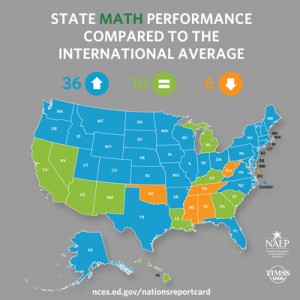Judging from the mainstream education news you read, the US is in big trouble. Our students are falling behind. Little countries like Finland and Singapore are going to take over the world with their fantastically well-educated populations. Our public schools are so broken, we should pay corporations and churches to educate our youth instead.
If you only read general interest press, what you don’t read are articles like this one in Education Week, which highlights the startling research that shows we’re doing just fine… most of us, that is. The article focuses on new data that compares students’ achievements in math and science by state rather than aggregated from the whole country. The result is what anyone who is paying attention could tell you: our poorest, most culturally conservative, and/or most economically and linguistically diverse states are, indeed, suffering when compared on a world stage.

But here’s the good news: in our states where education is well-funded, where kids are relatively well-fed, and where educators aren’t expected to push non-English speaking students through curriculum not designed for their success, we’re doing just fine. More than fine, really. States like Massachusetts, Minnesota, and Vermont “outperformed all but five of 47 countries, provinces, and jurisdictions abroad in mathematics.” In science, top scorers included Massachusetts, Vermont, and New Hampshire.
So are our schools failing or not? It depends on where the school is and who the students are.
I think that in order to understand public education in the United States, you have to understand the United States first. Unlike Finland or Singapore, we are not a small country with a single, central government. Unlike Korea and Finland, we do not have a highly homogenous culture and only one educational approach. Unlike all these countries, we have a huge immigrant population and an enduring underclass of children whose first five years are so drastically different from upper class kids’ preschool years that to expect them to perform well in the same kindergarten classroom is simply silly.
The United States is a republic of states which until recently were left on their own to determine their approach to public education. The differences in how children were educated in this country were very wide until No Child Left Behind, and great differences persist today in the quality of educational approach, even as the core curriculum is becoming more standardized. Thinking of it this way, it’s no surprise that some states vastly outperform others—the same way that some teachers vastly outperform others and some schools do the same.
It’s also very clear, when looking at the list of states that achieve near the top in math and science, that socioeconomic factors matter. The deep South, with its enduring poverty, conservative approach to education, and poor economies supported by handouts from richer states, is not represented in that list.
Also performing badly are some of the band of states along the border with Mexico, burdened as they are with educating large numbers of kids who arrive in kindergarten lacking the English language skills, physical health, and stimulating home environments provided by middle class, educated families.
What this means to me is that we need to stop trying to look at the question of whether the United States as a whole is succeeding in educating our children well. That question is meaningless and doesn’t deserve to be answered. What we need to start doing is to pay more attention to the different educational needs of different populations:
- Every study has confirmed the huge effects of poverty on parenting and academic achievement. There is no excuse for us to be talking about cutting expenses like free breakfasts for poor kids if our real intent is to educate all children well. Good education starts with breakfast.
- Every educator can tell you that the combination of poverty and immigrant status creates important differences in the needs that children have at school. Yes, we can all point to poor Mexican-Americans who grew up to be judges, but in general, a population of kids with linguistic, cultural, and economic barriers to American-style education needs to be educated differently than kids without these factors. We need to fully fund the education of these kids, and educate them as a resource for rather than a liability to our country.
- We need to be frank about the way some of our states are run. States with progressive approaches to education see money being sucked out in the form of federal taxes, which then go out to states sticking with old-fashioned, outmoded educational approaches.
I’d like to see Americans answering the question of how we’re educating kids with a lot more nuance and understanding of where we are coming from, and how we are different from other countries. No other high-achieving country has the burdens we have. No other country of our size has the governmental system that we have. When comparing American schoolchildren to Finnish schoolchildren, I’d like to see the comparison of well-fed, well-educated, middle class Americans only. What sense is there in comparing a Finnish student to an Alabama youth who had never touched a book before kindergarten and arrives hungry to school each day? What sense is there comparing a Korean raised in a highly educated, largely homogenous culture to a poor immigrant American whose parents are struggling just to keep their family intact and fed?
American education is not a melting pot. It’s a beautiful, ugly, creative, hodgepodge, well-constructed, fraying-at-some-edges patchwork quilt. If we really want to “fix” education in America, we need to get to work fixing what’s wrong with the quilt, rather than cutting out what’s right.
Comments
3 responses to “Rethinking the education problem”
Very thoughtful! Have you read about the Cristo Rey schools? http://www.cristoreysanjose.org Parmalee
Thanks for the link – I’ll take a look!
This is a great video that breaks down the myths about American education as compared to other countries – watch it! http://www.upworthy.com/5-myths-about-our-schools-that-fall-apart-when-you-look-closer-6?g=2